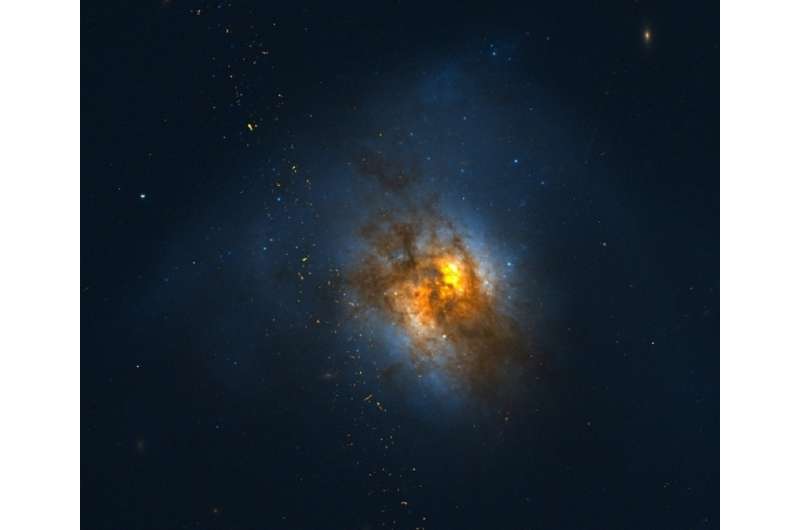Astrophysicists detect most luminous diffuse gamma-ray emission from Arp 220

A University of Oklahoma team has detected for the first time the most luminous gamma-ray emission from a galaxy—the merging galaxy Arp 220 is the nearest ultraluminous infrared galaxy to Earth, and it reveals the hidden extreme energetic processes in galaxies. The first gamma-ray detection of an ultraluminous infrafred galaxy occurs when the most energetic cosmic rays collide with the interstellar medium causing these galaxies to glow—expanding observations of these galaxies to the highest energy ranges. Luminous infrared galaxies and ultraluminous infrared galaxies—many of them the product of mergers between galaxies—are the most luminous of all galaxies.
Xinyu Dai, professor in the Homer L. Dodge Department of Physics and Astronomy, OU College of Arts and Sciences, with team members Rhiannon Griffin, OU graduate assistant, and Todd Thompson, professor in the Department of Astronomy and Center for Cosmology and Astro-Particle Physics, Ohio State University, made the discovery after collecting data using the National Aeronautics and Space Administration's Fermi Gamma-Ray Space Telescope.
"These galaxies are different because of their immense star formation and extra dust that scatters the light and makes them luminous in the infrared," said Griffin. "With this detection, we are expanding the range of energies used to study these galaxies."
"We are very excited about this discovery," said Dai. "The gamma-ray light unveils the population of extreme energetic particles in galaxies, and this discovery shows that the cosmic ray content is proportional to the luminosity of galaxies, even for the most luminous one."
Griffin and Dai developed the data collection methodology used to detect the gamma-ray emission from Arp 220. The massive amounts of star formation found in luminous infrared galaxies and ultraluminous infrared galaxies mean lots of massive stars go supernovae—the last stage of a massive star's life marked by one final huge explosion. The explosion accelerates numerous particles to relativistic speeds. These particles become cosmic rays that interact, resulting in particles and light, including gamma-ray emissions. Since cosmic rays are difficult to measure, gamma-rays reveal a hidden energy component in galaxies.
Arp 220 is situated some 250 million light years away, and its center contains over 200 huge star clusters. The most massive of these clusters contains enough material to equal about 10 million suns—twice as massive as any comparable star cluster in the Milky Way. The gamma-ray emission is expected to trace two compact disks in the nucleus of Arp 200, which contains almost all star-formation activities in this galaxy.
This research used publicly available data from Fermi-LAT. NASA and the National Science Foundation provided support for this project. A paper (Griffin et al. 2016) on this research has been published in the Astrophysical Journal Letters (Vol. 823, Issue 1, Article id L17).
Journal information: Astrophysical Journal Letters
Provided by University of Oklahoma





















